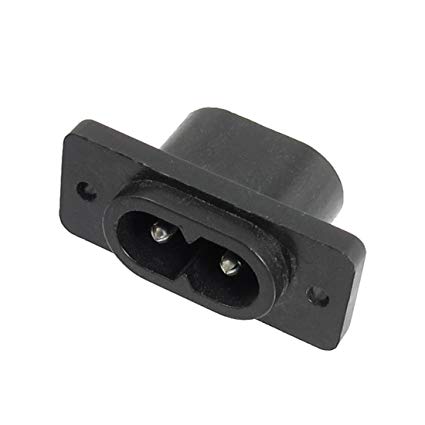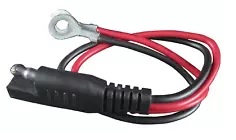 |
Matronics Email Lists
Web Forum Interface to the Matronics Email Lists
|
| View previous topic :: View next topic |
| Author |
Message |
trigo(at)mail.telepac.pt
Guest
|
 Posted: Sun Jan 19, 2020 10:49 am Post subject: External socket to charge the airplane batteries Posted: Sun Jan 19, 2020 10:49 am Post subject: External socket to charge the airplane batteries |
 |
|
Guys
In my RV-10 both batteries (main Batt - Odissey PC-925, and Aux Batt - Odissey PC-680) are in the back, inside the tail cone, behind the baggage compartment.
This is a difficult place to reach, in the completed airplane, to connect the clamps of a battery charger/maintainer.
Therefore I am going to install an external socket like this
in the airplane skin, to be easy to connect the charger from the outside.
I am thinking in connecting both batteries to this socket through a SPDT switch, to be able to select which battery to be charged.
Now the questions:
1 - which is the current flowing through this socket when charging?
2 - consequently, which gauge of wires should be used (#1 ? ?
3 - should I use any fuse in this circuit? If yes, which A?
4 - is there any possibility to charge both batteries at the same time? If yes, which is the smart way to achieve that?
Thanks in advance
Carlos
| | - The Matronics AeroElectric-List Email Forum - | | | Use the List Feature Navigator to browse the many List utilities available such as the Email Subscriptions page, Archive Search & Download, 7-Day Browse, Chat, FAQ, Photoshare, and much more:
http://www.matronics.com/Navigator?AeroElectric-List |
|
| Description: |
|
| Filesize: |
10.6 KB |
| Viewed: |
2697 Time(s) |

|
|
|
| Back to top |
|
 |
cluros(at)gmail.com
Guest
|
 Posted: Sun Jan 19, 2020 2:29 pm Post subject: External socket to charge the airplane batteries Posted: Sun Jan 19, 2020 2:29 pm Post subject: External socket to charge the airplane batteries |
 |
|
Carlos I think your plan is way too complicated. My RV-10 has a fuse protected battery charging cord connected to each battery and going to the baggage compartment. If I want to charge that battery, I open the baggage door and plug into that battery. No external door, no switch.
First select and purchase the charger. With many chargers you can disconnect the alligator clips and there is some sort of plug. Use the same plug on the end of the battery cable. My charger came with one free battery cable, the second one was $10. Many of these chargers use 2 prong automotive plugs which are cheap and available everywhere.
On Sun, Jan 19, 2020 at 1:24 PM Robert L. Nuckolls, III <nuckolls.bob(at)aeroelectric.com (nuckolls.bob(at)aeroelectric.com)> wrote:
| Quote: | At 12:46 PM 1/19/2020, you wrote:
| Quote: | Guys
In my RV-10 both batteries (main Batt - Odissey PC-925, and Aux Batt - Odissey PC-680) are in the back, inside the tail cone, behind the baggage compartment.
This is a difficult place to reach, in the completed airplane, to connect the clamps of a battery charger/maintainer.
Therefore I am going to install an external socket like thisin the airplane skin, to be easy to connect the charger from the outside. |
That's an AC power connector . . . not polarized.
No feature to prevent reversed connection.
This is not a very environmentally robust
device either.
Is your airplane hangared? How about putting
a goof-proof connector just inside the baggage
compartment . . . leave door ajar and plug in
shore-power. Connector stays out of weather.
| Quote: | | I am thinking in connecting both batteries to this socket through a SPDT switch, to be able to select which battery to be charged. |
What kind of charger?
| Quote: | Now the questions:
1 - which is the current flowing through this socket when charging? |
Depends on charger.
| Quote: | 2 - consequently, which gauge of wires should be used (#1 ? ?
3 - should I use any fuse in this circuit? If yes, which A?
4 - is there any possibility to charge both batteries at the same time? If yes, which is the smart way to achieve that? |
The only time you need to CHARGE a battery
is if you parked the airplane in a less-than-
full state of charge. The only time you need
to plug-in is if the airplane is going to be
parked for an extended period of time.
You don't need a switch, there's a way
to wire a 3-terminal connector to effect
battery paralleling for the purpose of
MAINTAINING. But if you anticipate a need
to CHARGE less than topped-off batteries,
then we need to discuss the brand/model
of charger.
Have you published a power distribution
diagram. How are these batteries wired
and controlled?
Bob . . .
|
| | - The Matronics AeroElectric-List Email Forum - | | | Use the List Feature Navigator to browse the many List utilities available such as the Email Subscriptions page, Archive Search & Download, 7-Day Browse, Chat, FAQ, Photoshare, and much more:
http://www.matronics.com/Navigator?AeroElectric-List |
|
|
|
| Back to top |
|
 |
user9253
Joined: 28 Mar 2008
Posts: 1929
Location: Riley TWP Michigan
|
 Posted: Mon Jan 20, 2020 4:57 am Post subject: Re: External socket to charge the airplane batteries Posted: Mon Jan 20, 2020 4:57 am Post subject: Re: External socket to charge the airplane batteries |
 |
|
Install 2 of these, one on each battery. Fuse at 20 amps.
| | - The Matronics AeroElectric-List Email Forum - | | | Use the List Feature Navigator to browse the many List utilities available such as the Email Subscriptions page, Archive Search & Download, 7-Day Browse, Chat, FAQ, Photoshare, and much more:
http://www.matronics.com/Navigator?AeroElectric-List |
|
| Description: |
|
| Filesize: |
10.76 KB |
| Viewed: |
2678 Time(s) |

|
_________________
Joe Gores |
|
| Back to top |
|
 |
sportav8r(at)gmail.com
Guest
|
 Posted: Tue Jan 21, 2020 5:55 pm Post subject: External socket to charge the airplane batteries Posted: Tue Jan 21, 2020 5:55 pm Post subject: External socket to charge the airplane batteries |
 |
|
Gentlemen: planning a Z-12 -based dual alternator and single battery but with both alternator outputs paralleled into the 60A shunt and eliminating the Hall effect sensor for the standby alternator B-lead. The panel builder is politely suggesting I will be happier if I keep two independent current monitoring channels in place. Please review my missive to him and see if I am overlooking anything. Thanks!
Plan (1) - Wired using one each Shunt and Hall channels: 60A alternator is regulated at 14.4V. Adequate for all possible loads, it always outputs through the shunt and its current shows on the EFIS in that channel. 20A standby alternator is regulated at 13.0V. The Hall effect sensor reads zero current on the EFIS basically forever - not a very informative data channel on the EFIS. The day the primary alternator breaks a belt, the shunt current drops to zero, the Hall sensor shows alternator output from the standby, and the bus voltage drops quickly to ~13V as the standby alternator takes the load.
Plan (2) - Both alternators feeding through the shunt in parallel, no Hall sensor: Shunt shows combined output current from both alternators, which is always 100% primary alternator, 0% from standby (because it's regulated to 13 volts into a bus that's already at 14.4V). If the primary alternator ever fails, then the shunt current reading is 100% from the standby alternator. The bus voltage drops to ~13V which is the immediate clue the primary alternator is off-line.
This same behavior allows testing the alternators separately at any time the engine is running by switching off their field supplies one at a time and observing: current in scenario (1) or bus voltage in scenario (2). The shunt in (2) reads system loads regardless of which alternator is doing the work. The Hall in (1) reads zero except when a failure or test occurs. This just means the pilot has to look at a new EFIS channel to see current if the main fails.
In Plan (1), either the shunt or the Hall will always read zero. In plan (2), the shunt will always read current from one or the other alternator, but never both - and bus voltage is the indicator of which alternator is doing the work.
Not sure a Hall sensor that reads zero in normal operations and only tells me current that the shunt in (2) would show me just as well in a failure scenario is worth buying and wiring in.
On Sun, Jan 19, 2020 at 4:24 PM Robert L. Nuckolls, III <nuckolls.bob(at)aeroelectric.com (nuckolls.bob(at)aeroelectric.com)> wrote:
| Quote: | At 12:46 PM 1/19/2020, you wrote:
| Quote: | Guys
In my RV-10 both batteries (main Batt - Odissey PC-925, and Aux Batt - Odissey PC-680) are in the back, inside the tail cone, behind the baggage compartment.
This is a difficult place to reach, in the completed airplane, to connect the clamps of a battery charger/maintainer.
Therefore I am going to install an external socket like thisin the airplane skin, to be easy to connect the charger from the outside. |
That's an AC power connector . . . not polarized.
No feature to prevent reversed connection.
This is not a very environmentally robust
device either.
Is your airplane hangared? How about putting
a goof-proof connector just inside the baggage
compartment . . . leave door ajar and plug in
shore-power. Connector stays out of weather.
| Quote: | | I am thinking in connecting both batteries to this socket through a SPDT switch, to be able to select which battery to be charged. |
What kind of charger?
| Quote: | Now the questions:
1 - which is the current flowing through this socket when charging? |
Depends on charger.
| Quote: | 2 - consequently, which gauge of wires should be used (#1 ? ?
3 - should I use any fuse in this circuit? If yes, which A?
4 - is there any possibility to charge both batteries at the same time? If yes, which is the smart way to achieve that? |
The only time you need to CHARGE a battery
is if you parked the airplane in a less-than-
full state of charge. The only time you need
to plug-in is if the airplane is going to be
parked for an extended period of time.
You don't need a switch, there's a way
to wire a 3-terminal connector to effect
battery paralleling for the purpose of
MAINTAINING. But if you anticipate a need
to CHARGE less than topped-off batteries,
then we need to discuss the brand/model
of charger.
Have you published a power distribution
diagram. How are these batteries wired
and controlled?
Bob . . .
|
| | - The Matronics AeroElectric-List Email Forum - | | | Use the List Feature Navigator to browse the many List utilities available such as the Email Subscriptions page, Archive Search & Download, 7-Day Browse, Chat, FAQ, Photoshare, and much more:
http://www.matronics.com/Navigator?AeroElectric-List |
|
|
|
| Back to top |
|
 |
|
|
You cannot post new topics in this forum
You cannot reply to topics in this forum
You cannot edit your posts in this forum
You cannot delete your posts in this forum
You cannot vote in polls in this forum
You cannot attach files in this forum
You can download files in this forum
|
Powered by phpBB © 2001, 2005 phpBB Group
|




